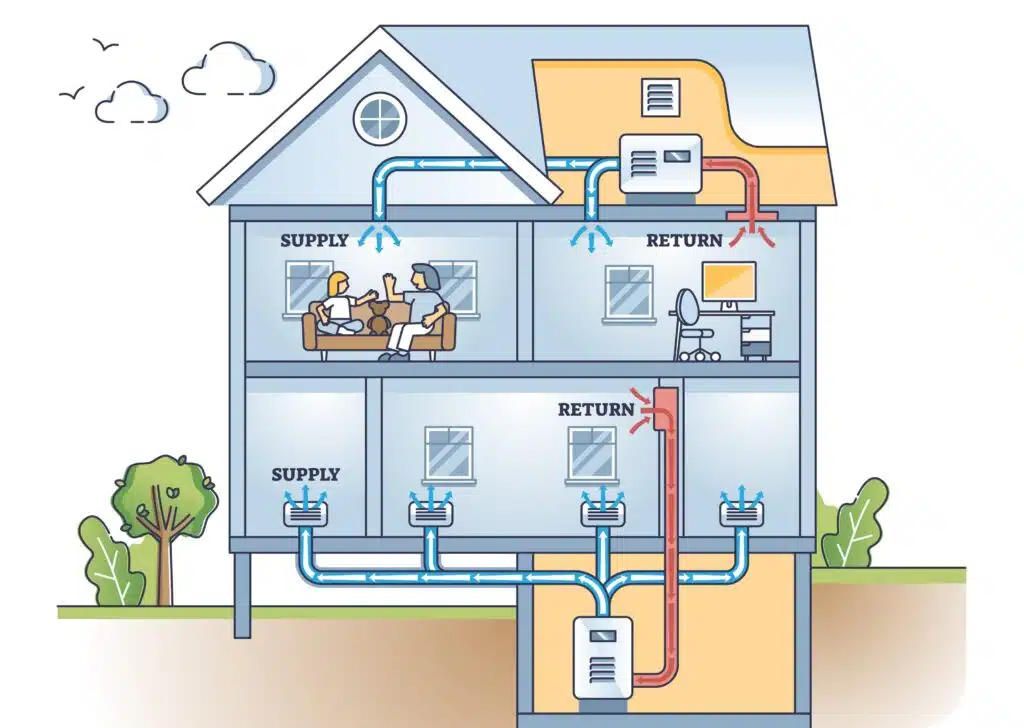
How Fort Worth’s Natural Light Impacts Indoor HVAC Load
HVAC load is directly influenced by natural light, which impacts indoor temperatures and energy use. In Fort Worth, where summers are hot and winters mild, efficient HVAC systems are essential for comfort and cost management. By strategically utilizing window placement, advanced glazing, and shading techniques, residents can harness daylight’s benefits while minimizing HVAC demands, enhancing sustainability and reducing energy expenses.
The Role of Natural Light in Indoor Temperature Regulation
Natural light is a double-edged sword when it comes to indoor temperature control and HVAC load. On one hand, sunlight entering a building can create passive heating, reducing the demand for artificial heating during cooler months.
This natural warmth can lessen the strain on HVAC systems and lead to energy savings. However, in warmer months, excessive solar heat gain can spike cooling needs, pushing HVAC systems to work harder and increasing energy consumption.
The effectiveness of managing natural light hinges on smart design strategies. Windows equipped with advanced features like low-emissivity (low-E) coatings and double glazing are essential.
These features help filter out excessive infrared and UV radiation while allowing visible light to illuminate indoor spaces, balancing brightness without significantly raising indoor temperatures.
Additionally, incorporating adjustable shading solutions—such as automated blinds and exterior louvers—offers flexible control over light and heat, which can significantly lower HVAC load.
For cities like Fort Worth, known for their hot summers, such measures are vital. The right combination of passive solar design and advanced glazing can harness sunlight effectively, minimizing heat during peak summer months while optimizing warmth in cooler periods.
This thoughtful approach not only enhances comfort but also promotes energy efficiency, reducing utility bills and contributing to a sustainable, eco-friendly lifestyle. Thoughtful management of natural light ensures it becomes an ally to the HVAC system, supporting a balanced indoor climate year-round.

Building Envelope and HVAC Load
A building’s envelope serves as the first line of defense against external temperature fluctuations, directly impacting the HVAC load. The envelope, encompassing walls, roofs, doors, and windows, must be designed to maintain a balanced indoor climate. This not only boosts energy efficiency but also reduces the strain on HVAC systems, leading to better performance and lower costs.
High-Performance Insulation
Effective insulation acts as a buffer against heat transfer, playing a crucial role in stabilizing indoor temperatures. Proper insulation with high R-values ensures minimal heat entry in the summer and heat escape in the winter. This regulation means the HVAC system operates less frequently, saving energy and enhancing comfort.
Airtight Construction
Airtightness is essential for preventing unwanted air exchange between the interior and the outdoors. Gaps or leaks in the building envelope can lead to drafts, temperature instability, and increased HVAC load as systems work harder to maintain set temperatures. A well-sealed envelope minimizes these issues, supporting efficient temperature control.
Optimized Window Design
Windows are a key part of the building envelope that heavily influences HVAC load. Energy-efficient windows, such as those with double or triple panes and low-emissivity (low-E) coatings, can filter excessive solar heat while still allowing light to brighten interiors. This design helps reduce cooling demands during hot months and prevents heat loss in cooler seasons.
Solar Gain Control
Managing solar heat gain is pivotal in reducing HVAC load. Strategic shading solutions, including adjustable blinds, exterior louvers, and well-placed overhangs, allow control over how much sunlight and heat enter a space. This not only prevents overheating during summer but also supports passive heating in cooler months, optimizing the balance between natural light and indoor temperature.
Climate-Specific Adaptations
In Fort Worth’s varied climate, a tailored approach to the building envelope is essential. Summers are often hot, demanding thoughtful solutions like solar control glass and insulated walls to manage the HVAC load effectively. Winter, while milder, still benefits from features that prevent heat loss and support energy efficiency.
A well-executed building envelope ensures that HVAC systems are not overworked, leading to improved indoor comfort, significant energy savings, and sustainable living. By combining insulation, airtight design, and advanced window technology, homeowners and businesses can achieve an environment that is both energy-efficient and comfortable year-round.
Glazing and Shading: Managing Solar Heat Gain
Controlling solar heat gain is essential for maintaining indoor comfort and reducing HVAC load. Proper use of glazing and shading not only optimizes natural light but also regulates temperature, preventing excessive heat buildup. This careful balance helps HVAC systems operate more efficiently, cutting energy consumption and costs.
Advanced Glazing Techniques
Modern glazing options significantly impact a building’s thermal performance. Low-emissivity (low-E) glass, double or triple-pane windows, and specialized coatings filter out infrared and UV radiation while still allowing natural light. These features reduce solar heat gain during hot months, maintaining a cooler interior without constant HVAC reliance. Additionally, insulated glass enhances thermal retention during colder months, further balancing HVAC demand.
External Shading Solutions
Incorporating external shading devices such as adjustable louvers, overhangs, and exterior blinds can effectively block high-angle summer sun while allowing lower-angle winter sunlight to enter. This strategic shading minimizes unwanted heat and glare, supporting the HVAC system in maintaining a consistent indoor temperature.
Dynamic Shading Systems
For more precise control, automated shading solutions provide responsive adjustments throughout the day. These systems can adapt to the sun’s position, optimizing interior conditions and reducing solar gain as needed. By integrating sensors and smart technology, building occupants can benefit from natural light without the associated increase in HVAC load.
Strategic Placement and Design
Beyond advanced materials, thoughtful placement of windows and design features like deep eaves or angled slats can enhance shading. Positioning windows to maximize or limit exposure based on seasonal sun paths reduces HVAC energy use by balancing solar gain.
By combining high-performance glazing and adaptive shading solutions, homeowners and builders can create energy-efficient spaces that leverage natural light while controlling temperature. This synergy between design and technology not only supports comfort but also enhances sustainability, making HVAC systems more effective and reducing environmental impact.
Seasonal Impacts of Natural Light on HVAC Systems
Natural light influences indoor temperature regulation throughout the year, directly affecting HVAC load. Understanding these seasonal impacts allows for more strategic use of natural light and more efficient HVAC system operation.
In summer, the intense sunlight can lead to significant solar heat gain, which raises indoor temperatures and increases the cooling load on HVAC systems. Without proper interventions like external shading, window films, or low-emissivity (low-E) coatings, this additional heat pushes HVAC systems to work harder, consuming more energy.
Implementing solutions such as adjustable blinds, overhangs, or louvers helps limit heat entry while still allowing natural illumination. This thoughtful approach ensures indoor comfort while minimizing energy use.
Winter presents a different scenario. Natural light can become an ally, reducing the heating load on HVAC systems. South-facing windows capture the lower-angled winter sun, providing passive solar heating that offsets indoor heating needs.
This reduces HVAC energy consumption and helps maintain a cozy environment. However, shorter daylight hours and cooler outside temperatures require well-insulated windows and airtight seals to retain heat effectively and prevent drafts.
Fort Worth’s climate, with its hot summers and milder winters, requires an adaptable strategy to optimize HVAC load. Integrating advanced glazing, strategic window placements, and adjustable shading can help harness natural light’s benefits without the drawbacks. This balance ensures that during summer, excess heat is blocked to reduce cooling efforts, while in winter, sunlight is maximized to naturally warm indoor spaces.
With the right design elements, homes and buildings can use natural light to ease HVAC loads, promoting energy efficiency, comfort, and lower utility costs year-round.
The Influence of Building Orientation
Building orientation has a profound impact on HVAC load, affecting how much natural light and solar heat a building receives. By strategically positioning a building to optimize sunlight, energy efficiency can be greatly enhanced, and HVAC system demands can be reduced.
South-Facing Orientation
Buildings with a southern orientation capture the most sunlight throughout the day, which is especially beneficial during winter. This positioning maximizes low-angle sunlight, providing passive heating that can reduce the reliance on heating systems and lower HVAC load. By harnessing this natural warmth, buildings become more energy-efficient, saving on heating costs.
Challenges with East and West Exposures
East and west-facing windows often face issues with morning and afternoon sun, leading to increased heat gain during summer. This can cause indoor temperatures to rise significantly, elevating the cooling load on HVAC systems. Limiting windows in these directions or employing vertical shading, such as louvers and awnings, helps control this heat gain and reduces HVAC strain.
Benefits of North-Facing Windows
North-facing windows provide steady, diffused natural light without substantial heat gain. This makes them ideal for spaces requiring consistent lighting while maintaining a balanced temperature. This setup decreases cooling needs and supports HVAC efficiency by reducing artificial lighting dependence.
Strategic Shading Solutions
Incorporating architectural elements such as overhangs, deep eaves, and adjustable shades can enhance a building’s response to seasonal changes. These features help south-facing windows admit low winter sun while blocking high-angle summer sunlight. This thoughtful design keeps HVAC load balanced throughout the year.
Adaptability for Local Climate
In regions like Fort Worth, which experiences hot summers and cooler winters, an orientation strategy that incorporates shading and strategic window placement can create energy-efficient buildings. This reduces the overall HVAC load, promoting sustainability and enhancing comfort year-round.
Careful planning of building orientation, combined with intelligent shading and material use, ensures optimal energy use and reduces the workload on HVAC systems, resulting in lower costs and more sustainable living spaces.
Benefits of Passive Solar Design
Passive solar design is an effective architectural strategy that optimizes natural sunlight for heating and lighting, directly reducing HVAC load and energy consumption. By focusing on building orientation, strategic material use, and shading, this design approach creates comfortable and efficient spaces.
-
Energy Savings
Aligning buildings to face south in the northern hemisphere maximizes winter sunlight, offering substantial passive heating. This reduces the need for artificial heating, cutting energy usage and leading to lower utility bills. Such energy savings directly reduce the overall HVAC load, allowing systems to run less intensively.
-
Improved Indoor Comfort
Incorporating thermal mass, such as concrete or stone, helps stabilize indoor temperatures by absorbing sunlight during the day and releasing heat at night. This natural temperature regulation minimizes temperature swings, easing the strain on HVAC systems and enhancing occupant comfort.
-
Reduced Environmental Impact
By decreasing reliance on heating and cooling systems, passive solar design supports sustainable practices and reduces carbon emissions. This environmentally friendly approach aligns with green building standards, contributing to a smaller carbon footprint.
-
Enhanced Natural Lighting
Passive solar design maximizes the use of daylight, reducing the need for artificial lighting during the day. This not only saves energy but also creates bright, inviting interior spaces that boost well-being and productivity.
-
Seasonal Adaptability
Features like overhangs, eaves, and adjustable shading solutions ensure that buildings benefit from winter sun while blocking excessive summer heat. This adaptability helps maintain consistent indoor temperatures and optimizes HVAC load, supporting energy-efficient living throughout the year.
Integrating passive solar strategies into building design promotes energy conservation, reduces costs, and creates a sustainable, comfortable living environment.
Advanced Solutions: Daylighting Systems
Daylighting systems offer innovative methods to maximize natural light within buildings, effectively reducing energy use and HVAC load. These systems combine architectural and technological advancements to create spaces that are brighter, more comfortable, and energy-efficient.
Tubular Daylighting Devices (TDDs)
Known as solar tubes, these devices capture sunlight through rooftop domes and channel it indoors via reflective tubes. The dispersed light brightens spaces without significant heat gain, reducing the reliance on artificial lighting and minimizing HVAC load. This solution is especially useful for interior areas that lack direct window access.
Automated Shading Systems
Smart shading uses sensors to adjust blinds or shades automatically based on sun position and light intensity. By managing sunlight entry, these systems reduce glare and control solar heat gain, leading to more stable indoor temperatures and a decreased cooling load on HVAC systems.
Electrochromic Glass (Smart Glass)
This advanced glazing technology changes tint according to sunlight exposure, balancing natural light and heat intake. Smart glass helps maintain indoor comfort by blocking excessive heat during peak sun hours, which lowers HVAC load and contributes to energy savings.
Daylight-Redirecting Panels
These panels redirect sunlight deeper into buildings, distributing light more evenly and reducing glare. This approach optimizes indoor lighting and minimizes heat spots, ensuring that HVAC systems do not overcompensate for uneven temperature distribution.
Light Shelves
Placed near windows, light shelves reflect sunlight deeper into a space, improving overall illumination while limiting heat gain. By enhancing natural light use, these shelves decrease the need for artificial lighting and manage solar heat, keeping HVAC load balanced.
Daylighting systems blend architectural finesse with smart technology to create comfortable, efficient spaces. By reducing the strain on HVAC systems and maximizing the benefits of natural light, these solutions promote sustainable energy use and cost-effective building management.
Practical Tips for Reducing HVAC Load with Natural Light
Maximizing natural light while managing heat gain is crucial for reducing HVAC load and enhancing energy efficiency. Implementing strategic methods can create a balanced, well-lit, and comfortable indoor environment.
-
Choose Energy-Efficient Windows
Installing low-emissivity (low-E) or double-pane windows helps control solar heat gain. These windows allow natural light without significant heat transfer, maintaining brightness while minimizing HVAC strain.
-
Use Automated Shading
Integrate motorized blinds or smart shades that respond to changing sunlight levels. These systems prevent excess heat from entering during peak hours, supporting consistent temperatures and reducing cooling demands.
-
Implement Light Shelves
Light shelves reflect sunlight deeper into a room, spreading natural light effectively. This approach lessens the need for artificial lighting and reduces the HVAC load by controlling direct solar heat.
-
Add External Shading
Features like awnings or overhangs block high-angle summer sun while still allowing lower-angle winter sunlight. This keeps indoor spaces cooler in summer and helps conserve energy during colder months.
Applying these methods creates a sustainable environment, cuts energy costs, and optimizes HVAC system performance.
Natural light significantly impacts HVAC load and energy efficiency in Fort Worth. One Hour Air Conditioning & Heating of Fort Worth offers tailored solutions to optimize comfort. Contact us today for expert assistance.

FAQ
-
Why does natural light affect HVAC load?
Natural light influences HVAC load because it increases or decreases indoor heat levels. Sunlight entering through windows raises temperatures, boosting cooling needs in warm weather, while providing warmth in winter, potentially lowering heating demands.
-
What is the best way to minimize solar heat gain in summer?
To limit solar heat gain, use energy-efficient low-E glass, install external shading like awnings, and consider automated blinds. These techniques prevent excessive sunlight from overheating interiors, supporting a stable HVAC load.
-
Can smart windows reduce my HVAC energy use?
Yes, smart windows with electrochromic technology adjust tint based on sunlight, controlling heat and light entry. This reduces cooling needs and enhances HVAC efficiency.
-
How does window glazing impact indoor temperatures?
Double or triple-pane glazing with low-E coatings manages heat transfer, keeping interiors warmer in winter and cooler in summer. This balance reduces HVAC strain and promotes energy efficiency.
-
Does natural light benefit HVAC efficiency in winter?
Yes, it does. South-facing windows capture low winter sunlight, providing passive heating that reduces HVAC load and cuts energy costs.


